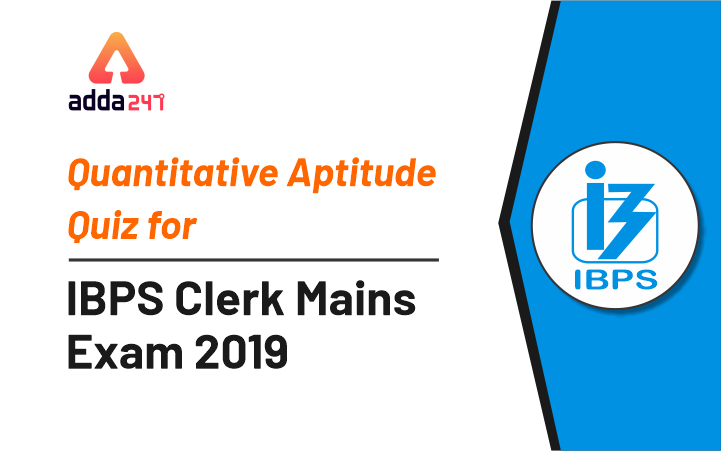Today quantitative aptitude mock is quantity based, misc. DI and missing series, which are important for the IBPS Clerk Mains examination. For more practice, you can follow a study plan of IBPS Clerk Mains and daily quantitative aptitude mock provided on bankersadda.
Direction (1-3): What should come in place of question mark (?) in the following number series?
Q1. 262, 234, 206, 178, 150, 122, ?
(a) 76
(b) 78
(c) 84
(d) 89
(e) 94
Q2. 4762, 4627, 4494, 4363, 4234, ?
(a) 4147
(b) 4137
(c) 4127
(d) 4117
(e) 4107
Q3. 672, 560, 448, 336, 224, ?
(a) 172
(b) 142
(c) 132
(d) 112
(e) 102
Directions (4-6): In each of these questions, two equations (I) and (II) are given. You have to solve both the equations and give answer
(a) if x>y
(b) if x≥y
(c) if x<y
(d) if x ≤y
(e) if x = y or no relation can be established between x and y.

(a) if x>y
(b) if x≥y
(c) if x<y
(d) if x ≤y
(e) if x = y or no relation can be established between x and y.

(a) if x>y
(b) if x≥y
(c) if x<y
(d) if x ≤y
(e) if x = y or no relation can be established between x and y.

(a) if x>y
(b) if x≥y
(c) if x<y
(d) if x ≤y
(e) if x = y or no relation can be established between x and y.
Q7. A cylinder whose height is equal to its radius is full of milk. Its milk is poured into a hemi spherical bowl of same radius as of cylinder and remaining milk is poured into another hemi-spherical bowl of same volume as of previous one. What percentage of the volume of second hemispherical bowl remained empty?
(a) 40%
(b) 66⅔%
(c) 33⅓%
(d) 50%
(e) 100%
Directions (8 – 12): Study the following graph and table carefully and answer the questions given below it.
Percentage of obese men, obese women and obese children in America in various years
Table shows total number of Men, Women and Children in the US over the years
Q8. What was the approximately average of obese men, obese women, and obese children in 2015?
(a)199900
(b)210000
(c)219000
(d)205460
(e)None of these
Q9. Find the total no of men who are not suffering from obesity in year 2014 and 2015 together?
(a)715000
(b)651000
(c)751000
(d)655700
(e)None of these
Q10. What was the respective ratio of the difference between the obese Men and Women in 2012 to the difference between total obese Women and Children in 2013?
(a) 199 : 1080
(b) 105 : 687
(c) 2 : 7
(d) 110 : 1099
(e) None of these
Q11. What is the difference between the total number of obese women and obese children in all the year?
(a)1055000
(b)1056000
(c)1017000
(d)1057000
(e)None of these
Q12. Total number of children not suffering from any obesity in 2015 and 2016 together is approximately what percent more or less than the total no of Men suffering from obesity in 2016 and total no. of women not suffering from obesity in 2013.?
(a)40%
(b)50%
(c)55%
(d)60%
(e)None of the above
Directions (13-15): In the following questions two quantities are given for each question. Compare the numeric value of both the quantities and answers accordingly.
Q13. ‘A’, ‘B’ and ‘C’ together can complete a work in 48 days if they work alternatively. ‘A’ is 25% more efficient than ‘B’ who is  less efficient than ‘C’.
less efficient than ‘C’.
Quantity I: Difference between days taken by ‘A’ alone and ‘C’ alone to complete the work.
Quantity II: Days in which ‘A’, ‘B’ and ‘C’ together can complete half of the work.
(a) Quantity I > Quantity II
(b) Quantity I < Quantity II
(c) Quantity I ≥ Quantity II
(d) Quantity I ≤ Quantity II
(e) Quantity I = Quantity II or No relation
Q14. Neeraj invested Rs. X in two different schemes ‘A’ and ‘B’ equally. Scheme A offers 10% p.a. at S.I and scheme B offers 20% p.a. at C.I. After 2 years he got total Rs.2560 interest from both the schemes.
Quantity I: Value of ‘X’
Quantity II: Rs. 7200
(a) Quantity I ≥ Quantity II
(b) Quantity I = Quantity II or No relation
(c) Quantity I > Quantity II
(d) Quantity I ≤ Quantity II
(e) Quantity I < Quantity II
Q15. Three partners invested capital in the ratio 2 : 7 : 9. The time period for which each of them invested was in the ratio of the reciprocals of the amount invested..
Quantity I: Profit share of the partner who brought in the highest capital if the profit is Rs. 1080
Quantity II: Profit share of the partner who brought in the lowest capital if the profit is Rs. 1080
(a) Quantity I > Quantity II
(b) Quantity I ≥ Quantity II
(c) Quantity I < Quantity II
(d) Quantity I = Quantity II or No relation
(e) Quantity I ≤ Quantity II
Solutions
Also Check:
Watch the Top 100+ DI for IBPS Clerk Mains
Check Latest Test Series and Online Classes for IBPS Clerk Mains:
- IBPS Clerk Mains 2019 Online Test Series
- VIJAYPATH BATCH FOR SBI CLERK Prelims| SBI CLERK | Bilingual
Register here to get study materials and regular updates!!
All the Best BA’ians for IBPS Clerk Mains 2019!
















 GA Capsule for SBI Clerk Mains 2025, Dow...
GA Capsule for SBI Clerk Mains 2025, Dow...
 The Hindu Review October 2022: Download ...
The Hindu Review October 2022: Download ...
 RRB NTPC Exam Date 2025, Expected CBT 1 ...
RRB NTPC Exam Date 2025, Expected CBT 1 ...





